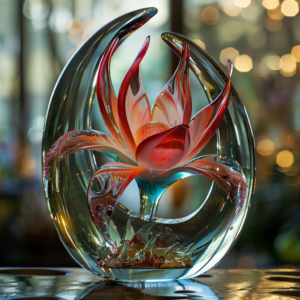Have you ever been mesmerized by the ethereal beauty of a glass sculpture? Perhaps the way light dances through its translucent form, revealing a captivating interplay of color and shape, ignited a spark of inspiration within you. The good news is, the magic of glass sculpting isn’t reserved for the chosen few. With a dash of creativity, the right techniques, and a healthy respect for safety, you too can unleash your inner glass sculptor and create stunning works of art.
Igniting Your Artistic Flame
Before diving into the technical aspects, let’s explore how to tap into your artistic vision. Here are some tips to get your creative juices flowing:
- Find Inspiration: Immerse yourself in the world of glass art! Visit museums, galleries, and online resources to explore the diverse styles and techniques employed by glass sculptors. What speaks to you? What kind of emotions and stories do you want your sculptures to convey?
- Develop Your Artistic Voice: Don’t be afraid to experiment! Sketch your ideas, gather materials that inspire you, and explore different color palettes. Developing your unique artistic voice will help you translate your vision into stunning glass art.
Mastering the Basics: Essential Techniques
There are several core techniques used in glass sculpting. Let’s delve into the most common ones:
- Glassblowing: This foundational technique involves blowing air through a blowpipe to create a bubble of molten glass. Sculptors then manipulate the glass with tools and hand movements to achieve their desired shape.
- Lampworking: This technique utilizes a torch to heat and manipulate small pieces of glass, ideal for creating intricate details or smaller sculptures.
- Fusing: Layers of colored glass are arranged together and then heated in a kiln until they bond, creating beautiful, multi-layered sculptures.
- Kiln Forming: Pre-made sheets of glass are shaped in a kiln using heat and gravity. This technique offers flexibility for creating curved shapes and larger pieces.
- Casting: Molten glass is poured into a pre-made mold to create detailed sculptures. This technique is ideal for replicating intricate designs.
Building Your Skills: Tips for Beginners
- Start Small: Don’t be intimidated by complex sculptures. Begin by practicing basic techniques with smaller pieces to develop your confidence and skills.
- Take a Class: Learning from an experienced glass sculptor in a studio environment is highly recommended. They can guide you through safety protocols, demonstrate techniques firsthand, and answer your questions.
- Practice Makes Perfect: As with any art form, consistent practice is key. The more you work with glass, the more comfortable you’ll become handling it and the more refined your skills will become.
Beyond Technique: Important Considerations
- Safety First: Glass sculpting involves working with extremely hot materials and requires proper safety gear such as gloves, safety glasses, and a respirator. Always prioritize safety throughout the process.
- Finding a Studio Space: Glass sculpting often requires access to specialized equipment like kilns and torches. Consider joining a community studio space or finding a studio that offers open access for independent artists.
- Building Your Tool Kit: As you progress, you’ll want to invest in essential tools like blowpipes, shaping tools, and safety equipment.
Conclusion
The journey of being a glass sculptor is an exciting one, filled with creativity, challenges, and the immense satisfaction of transforming a molten material into captivating works of art. Unleash your inner artist, embrace the learning process, and let the magic of glass ignite your artistic passion. With dedication and these helpful tips, you’ll be well on your way to crafting stunning glass sculptures that showcase your unique artistic vision.



